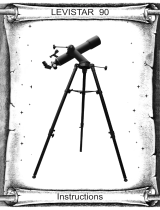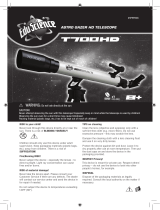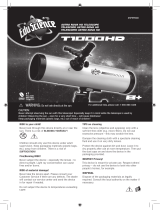Page is loading ...

Need Help? Toll Free 866.252.3811
1
RISK to your child!
Never look through this device directly at or near the sun. There is a
risk of BLINDING YOURSELF!
Children should only use this device under supervision. Keep
packaging materials (plastic bags, etc.) away from children. There is
a risk of SUFFOCATION!
Fire/Burning RISK!
Never subject the device - especially the lenses - to direct sunlight.
Light ray concentration can cause fires and/or burns.
RISK of material damage!
Never take the device apart. Please consult your Customer Service if
there are any defects. The dealer will contact our service centre and
send the device in for repair if needed.
Do not subject the device to temperatures exceeding 140 F.
TIPS on cleaning
Clean the lens (objective and eyepiece) only with a soft lint-free cloth
(e.g. micro-fibre). Do not use excessive pressure - this may scratch
the lens.
Dampen the cleaning cloth with a spectacle cleaning fluid and use it
on very dirty lenses.
Protect the device against dirt and dust. Leave it to dry properly after
use at room temperature. Then put the dust caps on and store the
device in the original gift box.
RESPECT Privacy!
This device is meant for private use. Respect others’ privacy – do not
use the device to look into other people’s house, for example.
DISPOSAL
Dispose of the packaging material/s as legally required. Consult the
local authority on the matter if necessary.
CF700mm
Telescope
CAUTION:
Never attempt observing the sun with this telescope! Especially keep it in mind while the telescope is used by children! Observing the
sun – even for a very short time – will cause blindness! Packing material (plastic bags, etc.) has to be kept out of reach of children!

2
Need Help? Toll Free 866.252.3811
CF700mm Telescope
Fig 1 Fig 2 Fig 3
Fig 6 Fig 5
Fig 4
1
4
5
9
8
5
9 3
13
10
11
12
8
7
2
6
14

Need Help? Toll Free 866.252.3811
3
Parts Listing
Please check while unpacking, if all parts are complete:
1. Objective lens
2. Tripod with accessory tray
3. Telescope mounting arm with clamp
4. Telescope tube with dew shield
5. Red Dot Viewfinder
6. Plssl Eyepiece 26mm
7. Plssl Eyepiece 9.7mm
8. Diagonal mirror
9. Slow motion control cable
10. Tension knob azimuth (left and right)
11. Tension knob altitude (up and down)
12. Focuser
13. Azimuth Wheel
14. 2x Barlow
Setting Up
It is recommended to do the first set-up during the daytime to
familiarize yourself with steps and components of setting up your
telescope. Now you may easily set up the telescope even in low
light.
1. Spread the tripod legs until the tripod spreaders are level.
Afterwards, put the accessory tray in place and lock it by turning by
60Fig 2. Now you can set the tripod height by adjusting the single
legs with their locking clamps Fig 1.
2. Insert the mounting arm from above into the mount hole at the
tripod head and lock it with the black screw Fig 3.
3. Set the telescope tube with the threaded bolts from the left into
the clamp so that the bolts fit into the clamp's holes. Then screw the
black locking nuts and tighten them to a firm feel Fig 4.
4. Finally, put the Red Dot Viewfinder from the back in its holder
Fig 5.
5. Slide diagonal into Focuser (turn silver screws until snug) and
insert the 26mm Pssl eyepiece in to the diagonal (turn silver screws
until snug).
Aligning the Red Dot Viewfinder
Your telescope is designed for terrestrial and astronomical
observations. Please keep in mind that heat turbulences in the air
are also magnified. In warm conditions, it can be useful to limit
observations to medium magnifications.
First, remove the dust cover from the object lens.
*Please make sure to remove plastic insulator from battery Fig 6.*
Insert the 26mm Plssl Eyepiece into the diagonal, you may
now adjust the focus with the draw tube's wheel. The Redo Dot
Viewfinder is activated by sliding the switch on its right side; there
are two intensities available. Before the first observation, the
viewfinder has to be aligned to the telescope. For this, point at a
striking target (e.g. telephone pole) with the telescope's eyepiece.
Now, without moving the telescope, switch on the viewfinder and
adjust the red dot with the 2 adjustment screws (left and right - up
and down) until it fits in the eyepiece's view. Now the viewfinder is
aligned and ready to point for the telescope.
Hint: Don't forget to switch off the viewfinder after use!
Using the Telescope
Once you setup your telescope and aligned your viewfinder, you
will now be ready to use your telescope. On the side and on top of
the telescope mount head you will find tension knobs (#10) for the
azimuth and (#11) for altitude. Loosen both knobs while holding
the telescope near the focuser (#12). Slowly move the telescope
close to the desired object to b e observed and tighten the altitude
and azimuth tension knobs. While viewing through your red dot, use
both the slow motion altitude control and the side azimuth wheel
(#13) for centering the desired object. Once centered you will be
able to view through the eyepiece and make minor adjustments to
the location using the altitude control and azimuth wheel.
Hint: The object will appear as if it is moving in an elliptical path
across the sky. You can make adjustments using the slow motion
controls on the mount head.
Cleaning / Maintenance
Your telescope should, like every optical instrument, be treated with
care and stored dry. Doing so will maintain its optical performance
for many years. After using, the dust cover should be closed after
dew has dried off. The lenses can be cleaned with a soft brush
available from photo stores. Don’t ever use sharp detergents like
gasoline or thinner to clean the optics!
The Red Dot Viewfinder is
powered by a battery type CR-2032 (3V);
if a replacement is necessary, remove
cap (Fig. 1) by unscrewing set screw
(Fig. 2) and sliding battery towards the
front. Slide new battery in place with the
positive (+) side showing.
Replace cap and tighten with
set screw (Fig. 2).
Technical Data
Objective Diameter: 70mm
Focal Length: 700mm
Focal Ratio: f/10
Design: Achromatic
Magnifications
w/ Plssl eyepiece 26mm: 26.9x and with 2x Barlow: 52x
w/ Plssl eyepiece 9.7mm: 72x and with 2x Barlow: 144x
To make things simpler, please review the table with some
magnifications:
Red Dot Viewfinder
(bottom view)
WARNING:
Never use a telescope to look at the sun! Looking at or
near the sun will cause instant and irreversible damage
to your eye. Eye damage is often painless, so there is no
warning to the observer that damage has occurred until
it is too late. Do not point the telescope or its viewfinder
at or near the sun. Do not look through the telescope or
its viewfinder as it is moving. Children should always
have adult supervision while observing.
Available Downloads:
Instruction Manual, Planisphere, Software
Visit:
http://exploreone.com/pages/product-manuals
Fig 2
Fig 1
Front
Telescope Focal
Length
Focal Length of
Eyepiece
Magnification
without 2x Barlow with 2x Barlow
700mm 26mm 26.9x 52x
700mm 9.7mm 72x 144x

4
Need Help? Toll Free 866.252.3811
Possible objects for observation:
We have compiled and explained a number of very interesting
celestial bodies and star clusters for you but we suggest that you
start practicing during the day focusing on terrestrial objects
such as Birds and or Trees at varying distances from you. On the
accompanying images at the end of the instruction manual, you can
see how objects will appear in good viewing conditions through your
telescope at varying powers (see pictorial examples below).
Terrestrial Views
Please note the example picture of Mount Rushmore. Start with
the 26mm Plössl eyepiece and focus until clear. After mastering
the focus with the 26mm change the 9.7mm eyepiece and practice
focusing and scanning until images become clear in the eyepiece.
We have included some additional examples that are possible with
your telescope such as a bird and a green on a golf course. DO NOT
POINT YOUR TELESCOPE DIRECTLY AT THE SUN OR BLINDNESS IS
POSSIBLE.
The Moon
The moon is the Earth’s only natural satellite.
Diameter: 3.476km
Distance: approx. 384,401km
The moon has been known to humans since prehistoric times. It
is the second brightest object in the sky (after the sun). Because
the moon circles the Earth once per month, the angle between
the Earth, the moon and the sun is constantly changing; one sees
this change in the phases of the moon. The time between two
consecutive new moon phases is about 29.5 days (709 hours).
Orion Nebula (M 42)
M 42 in the Orion constellation
Right ascension: 05:32.9 (Hours: Minutes)
Declination: -05:25 (Degrees: Minutes)
Distance: 1.500 light years
With a distance of about 1500 light years, the Orion Nebula (Messier
42, abbreviation: M 42) is the brightest diffuse nebula in the sky –
visible with the naked eye, and a rewarding object for telescopes
in all sizes, from the smallest field glass to the largest earthbound
observatories and the Hubble Space Telescope.
When talking about Orion, we‘re actually referring to the main part
of a much larger cloud of hydrogen gas and dust, which spreads out
with over 10 degrees over the half of the Orion constellation. The
expanse of this enormous cloud stretches several hundred light
years.
Ring Nebula in Lyra constellation (M 57)
M 57 in the Lyra constellation
Right ascension: 18:51.7 (Hours: Minutes)
Declination: -+32:58 (Degrees: Minutes)
Distance: 2,000 light years
The famous Ring Nebula M 57 in the constellation of Lyra is often
viewed as the prototype of a planetary nebula; it is one of the
magnificent features of the Northern Hemisphere's summer sky.
Recent studies have shown that it is probably comprised of a ring
(torus) of brightly shining material that surrounds the central star
(only visible with larger telescopes), and not of a gas structure in the
form of a sphere or an ellipsis. If you were to look at the Ring Nebula
from the side, it would look like the Dumbbell Nebula (M27). With
this object, we’re looking directly at the pole of the nebula.
Dumbbell Nebula in the Vulpecula (Fox) constellation (M 27)
M 27 in the Fox constellation
Right ascension: 19:59.6 (Hours: Minutes)
Declination: -+22:43 (Angle: Minutes)
Distance: 1,250 light years
The Dumbbell Nebula (M 27) in Fox was the first planetary nebula
ever discovered. On July 12, 1764, Charles Messier discovered this
new and fascinating class of objects. We see this object almost
directly from its equatorial plane. If you could see the Dumbbell
Nebula from one of the poles, it would probably reveal the shape of
a ring, and we would see something very similar to what we know
from the Ring Nebula (M 57). In reasonably good weather, we can
see this object well even with small magnifications.
Terrestrial Images
f=26mm
f=26mm
The Moon
Orion Nebula (M 42)
Ring Nebula in Lyra
constellation (M 57)
Dumbbell Nebula
in the Vulpecula
(Fox) constellation
(M 27)
f=9.7mm
f=9.7mm

Need Help? Toll Free 866.252.3811
5
Telescope ABC’s
What do the following terms mean?
Diagonal:
A mirror that deflects the ray of light 90 degrees. With a horizontal
telescope tube, this device deflects the light upwards so that you can
comfortably observe by looking downwards into the eyepiece. The
image in a diagonal mirror appears upright, but rotated around its
vertical axis (mirror image.)
Focal Length:
Everything that magnifies an object via an optic (lens) has a certain
focal length (FL). The FL is the length of the path the light travels
from the surface of the lens to its focal point. The focal point is also
referred to as the focus. In focus, the image is clear. In the case
of a telescope, the FL of the telescope tube and the eyepieces are
combined.
Lens:
The lens turns the light which falls on it around in such a way so that
the light gives a clear image in the focal point after it has traveled a
certain distance (focal length).
Eyepiece:
An eyepiece is a system made for your eye and comprised of one or
more lenses. In an eyepiece, the clear image that is generated in the
focal point of a lens is captured and magnified still more.
There is a simple formula for calculating the magnifications:
Focal length of the telescope tube / Focal length of the eyepiece =
Magnification.
You see: In a telescope, the magnification depends on both the focal
length of the telescope tube and the focal length of the eyepiece.
Magnification:
The magnification corresponds to the difference between
observation with the naked eye and observation through a
magnification apparatus (e.g. a telescope). In this scheme,
observation with the eye is considered "single", or 1x magnification.
Accordingly, if a telescope has a magnification of 30x, then a object
viewed through the telescope will appear 30 times larger than it
would with the naked eye. See also, "Eyepiece"
Troubleshooting:
Mistakes: Help:
No picture Remove dust protection cap and sun-
shield from the objective opening.
Blurred picture Adjust focus using focus ring
No focus possible Wait for temperature to balance out
Bad picture Never observe through a glass surface
Viewing object visible Adjust finder
in the finder, but not
through the telescope
Despite using star The star diagonal prism
diagonal prism should be vertical in
the picture is "crooked" the eyepiece connection
Customer Service Questions:
1.866.252.3811
DISPOSAL
Dispose of the packaging materials properly,
according to their type (paper, cardboard, etc).
Contact your local waste disposal service or
environmental authority for information on the
proper disposal.
Please take the current legal regulations into
account when disposing of your device. You can
get more information on the proper disposal
from your local waste disposal service or
environmental authority.

6
Need Help? Toll Free 866.252.3811
Notes:

Need Help? Toll Free 866.252.3811
7
Notes:

8
Need Help? Toll Free 866.252.3811
© 2016 National Geographic Partners, LLC. All rights reserved.
NATIONAL GEOGRAPHIC and Yellow Border Design are trademarks
of the National Geographic Society, used under license.
Visit our website: www.nationalgeographic.com
©2016 Explore Scientific®, LLC. All rights reserved.
explorescientific.com | exploreone.com | 866.252.3811
Made in China.
CONFORMS TO THE SAFETY REQUIREMENTS OF ASTM F963
/


